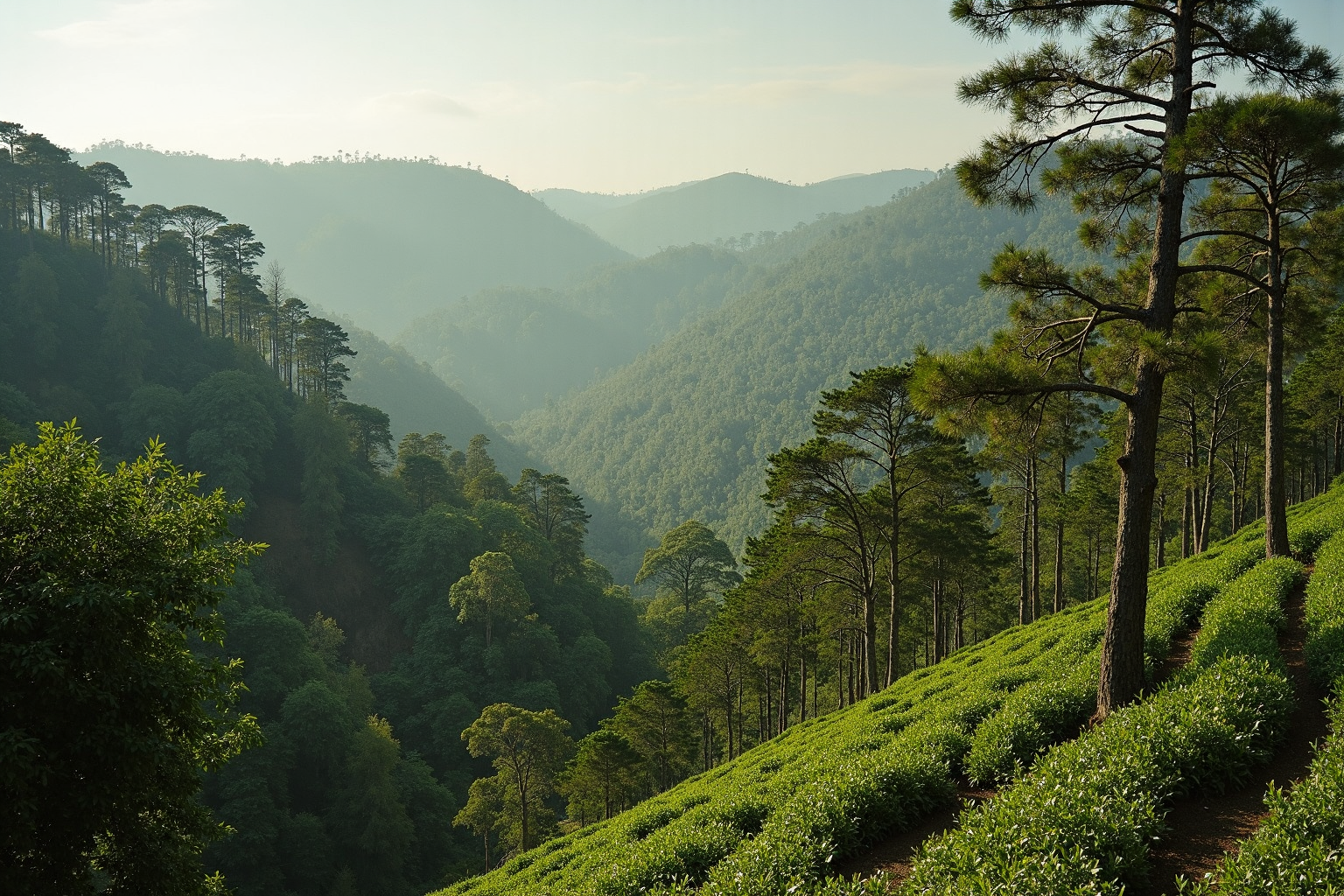Introduction: The Fragile Cradle of Coffee
Ethiopia, often hailed as the birthplace of Arabica coffee, harbors a treasure trove of biodiversity within its wild coffee forests. These forests represent a vital reservoir of genetic diversity for Coffea arabica, the world’s most beloved coffee species, serving as a critical resource for the future resilience of the global coffee industry. This genetic diversity is essential for developing coffee varieties resistant to pests, diseases, and the increasing pressures of climate change. The wild coffee forests of Ethiopia, primarily located in the southwestern highlands, provide a unique and complex ecosystem that supports not only coffee plants but also a vast array of flora and fauna, many of which are endemic to the region. However, these irreplaceable natural resources face escalating threats from deforestation driven by agricultural expansion, unsustainable logging practices, and the impacts of a changing climate. Preserving these natural cradles of coffee is not merely an act of conservation; it’s a strategic imperative for the long-term sustainability of the coffee industry worldwide. It’s about protecting the rich biodiversity of these unique ecosystems, supporting the livelihoods of local communities who depend on these forests, and ensuring the future of coffee itself. The economic implications are significant, as coffee remains a cornerstone of the Ethiopian economy, providing livelihoods for millions. Furthermore, the cultural significance of coffee in Ethiopia is deeply intertwined with these forests, representing centuries of tradition and knowledge. This article delves into the multifaceted efforts to conserve Ethiopian coffee forests, examining the delicate balance between ecological integrity, economic development, and the preservation of cultural heritage. We will explore the innovative approaches being implemented, from sustainable harvesting practices and community-led conservation initiatives to the role of certification programs and the integration of traditional knowledge in safeguarding these vital ecosystems for generations to come. The fate of these forests is inextricably linked to the future of coffee, and understanding the challenges and opportunities in their conservation is crucial for all stakeholders, from coffee farmers to consumers worldwide.
Safeguarding Genetic Diversity: The Key to Resilience
The genetic diversity within Ethiopia’s wild coffee populations is truly unparalleled, representing a living library of the Coffea arabica species. These ancient forests, the very birthplace of coffee, harbor a vast array of coffee varieties, each possessing unique traits that could prove crucial in adapting to future challenges such as increased temperatures, new pests, and evolving diseases. This genetic richness is not just a scientific curiosity; it’s the foundation for the long-term resilience of coffee globally, allowing us to potentially breed varieties that are better suited to changing climates and more resistant to emerging threats. Preserving this genetic heritage is therefore paramount for the future of coffee production and the livelihoods of millions who depend on it. Seed banks and nurseries play a vital role in ex-situ conservation, carefully collecting and storing seeds from diverse coffee populations to safeguard them against extinction. These collections act as a backup, ensuring that the genetic potential of wild coffee remains available for future breeding programs and research. However, the most effective conservation strategy is in-situ, which focuses on protecting coffee populations within their natural forest habitats. This approach not only preserves genetic diversity but also maintains the ecological integrity of the forests. In-situ conservation efforts often involve establishing protected areas, implementing sustainable harvesting practices, and supporting community-based conservation initiatives. These measures are crucial for ensuring that wild coffee populations continue to evolve and adapt naturally. The genetic diversity of Ethiopian coffee is not only important for the plant’s resilience but also for the unique flavor profiles it offers. The varied microclimates and altitudes within these forests have led to the development of distinct coffee varieties, each with its own characteristic taste and aroma. These unique flavor profiles are highly valued by coffee connoisseurs and contribute to the economic importance of Ethiopian coffee. Therefore, preserving the genetic diversity of these forests is not just an ecological imperative but also an economic one. Furthermore, the conservation of wild coffee is intrinsically linked to the broader effort to protect the Ethiopian forest ecosystem. These forests are biodiversity hotspots, home to a wide array of plant and animal species, many of which are endemic to the region. The health of these forests is critical for maintaining water resources, preventing soil erosion, and regulating local climate patterns. The loss of these forests would not only impact coffee production but also have devastating consequences for the entire ecosystem and the communities that rely on it. Fair trade practices play a crucial role in supporting the conservation of wild coffee by providing economic incentives for farmers to adopt sustainable harvesting methods and engage in forest protection efforts. By ensuring that coffee farmers receive fair prices for their crops, fair trade initiatives empower them to invest in conservation practices, such as agroforestry, that benefit both the environment and their livelihoods. This creates a virtuous cycle where economic development and environmental protection go hand in hand. Finally, effective forest conservation requires collaboration among various stakeholders, including government agencies, research institutions, non-governmental organizations, and local communities. By working together, these stakeholders can develop and implement comprehensive conservation strategies that address the complex challenges facing Ethiopian coffee forests. This includes promoting sustainable harvesting practices, supporting community-based conservation initiatives, and investing in research to better understand the genetic diversity of wild coffee and its potential for adaptation to climate change. The long-term success of these efforts depends on a holistic approach that integrates environmental, economic, and social considerations.
Sustainable Harvesting: Balancing Yield and Ecology
Sustainable harvesting practices are paramount for the long-term health and productivity of Ethiopian coffee forests, the very cradle of the world’s coffee genetic diversity. Traditional methods, refined over generations, emphasize a deep respect for the forest ecosystem. These methods involve selective harvesting, where only the fully ripe, red coffee cherries are handpicked, leaving the unripe ones to mature, thus minimizing damage to the coffee trees and the surrounding flora and fauna. This approach ensures the continued health of the coffee plants and promotes a balanced forest ecosystem, a practice deeply rooted in traditional knowledge and conservation ethics. The result is not only better forest health but also a higher quality coffee bean due to the careful selection of cherries at their peak ripeness.
Modern sustainable techniques further enhance these traditional methods, integrating coffee cultivation with other trees and crops through agroforestry systems. These systems promote biodiversity by creating a more complex and resilient ecosystem, mimicking the natural structure of the forest. For example, shade-grown coffee, a hallmark of Ethiopian coffee production, is a prime example of agroforestry, where coffee plants thrive under the canopy of native trees, providing habitat for birds and other wildlife, while also protecting the coffee plants from direct sunlight and temperature extremes. This approach not only contributes to forest conservation but also enhances soil health and water retention, reducing the need for external inputs and creating a self-sustaining system. These systems demonstrate a commitment to sustainable agriculture that benefits both the environment and the quality of the coffee beans.
Beyond agroforestry, other sustainable harvesting practices include careful soil management, avoiding the use of harmful chemicals, and water conservation techniques. For example, composting organic waste and using it as a natural fertilizer helps to maintain soil fertility and reduce reliance on synthetic fertilizers, which can have negative impacts on the environment. Water-efficient irrigation methods, such as drip irrigation, are also used to conserve water, a precious resource in many coffee-growing regions. These practices are critical for ensuring that coffee production is environmentally responsible and does not deplete natural resources. The adoption of these methods by Ethiopian coffee farmers not only promotes environmental sustainability but also positions them as leaders in responsible coffee production.
Fair trade principles are also intertwined with sustainable harvesting, ensuring that coffee farmers receive a fair price for their products and are incentivized to adopt these practices. Fair trade certification programs often require farmers to adhere to strict environmental standards, promoting sustainable agriculture and forest conservation. The premiums earned through fair trade sales provide farmers with the resources to invest in sustainable farming practices, further enhancing their ability to protect the environment and maintain the long-term viability of their coffee farms. This creates a positive feedback loop, where sustainable harvesting leads to higher quality coffee, which in turn leads to better economic outcomes for farmers, thus encouraging the continued adoption of these practices. The economic benefits of fair trade, coupled with the environmental benefits of sustainable harvesting, make it a crucial component of forest conservation in Ethiopia.
Furthermore, the knowledge and expertise of local communities are indispensable in implementing sustainable harvesting practices effectively. Their deep understanding of the forest ecosystem, passed down through generations, informs the most effective methods for managing the forest and harvesting coffee in a way that is both productive and environmentally responsible. By involving local communities in decision-making processes and providing them with the necessary training and resources, it is possible to ensure that sustainable harvesting practices are not only adopted but also effectively implemented and maintained over the long term. This participatory approach is essential for the success of any conservation effort, ensuring that the interests and needs of the local communities are prioritized and that they are empowered to act as the guardians of the forest.
Community Involvement: Guardians of the Forest
The fate of Ethiopia’s invaluable coffee forests rests largely in the hands of the communities who call these lands home. Their intimate knowledge of the ecosystem, coupled with their reliance on the forest for their livelihoods, makes them essential stewards of this natural heritage. Participatory forest management models recognize this crucial role, empowering local communities to actively shape decisions regarding forest use, protection, and resource allocation. This approach not only ensures that conservation strategies are culturally sensitive and relevant but also fosters a sense of ownership and responsibility within the community, leading to more effective and sustainable outcomes. For example, communities might decide on designated harvesting zones, sustainable logging practices, or the establishment of community-managed nurseries to replenish native tree species. In the Yayu Biosphere Reserve, a UNESCO-designated site, local communities participate in the management of the forest, contributing to the preservation of wild coffee populations and other valuable biodiversity. Benefit-sharing mechanisms are also crucial, ensuring that communities directly profit from conservation efforts. Fair trade initiatives, for instance, guarantee minimum prices for coffee and provide premiums that can be invested in community development projects, creating a powerful economic incentive for forest protection. This approach aligns economic prosperity with ecological stewardship, creating a sustainable model for both people and the planet. The cultivation of Ethiopian coffee is deeply intertwined with the cultural identity of the local communities. Traditional forest management practices, honed over generations, demonstrate a profound understanding of the delicate balance within the forest ecosystem. These practices often incorporate agroforestry systems, where coffee plants thrive under the shade of diverse native trees, mimicking the natural forest structure. This method not only provides crucial habitat for a variety of species, contributing to biodiversity conservation, but also enhances the quality of the coffee by providing natural shade and nutrient-rich soil. Moreover, these traditional practices often include customary laws and rituals that reinforce the importance of respecting and protecting the forest, passing down ecological wisdom through generations. Supporting and integrating these traditional practices into modern conservation strategies is essential for long-term success. Furthermore, empowering women in coffee-growing communities plays a critical role in sustainable forest management. Women are often deeply involved in coffee production, from harvesting to processing, and possess valuable knowledge about the forest ecosystem. Providing them with access to resources, training, and leadership opportunities can strengthen their role as environmental stewards and enhance the overall effectiveness of conservation efforts. Organizations like the International Women’s Coffee Alliance are working to empower women coffee producers in Ethiopia, contributing to both economic development and environmental sustainability. The preservation of Ethiopian coffee forests is not merely an environmental imperative; it is essential for the future of coffee itself. These forests serve as a vital reservoir of genetic diversity, harboring a vast array of coffee varieties, each with unique characteristics that could hold the key to adapting to future challenges, such as climate change and emerging diseases. Protecting this genetic heritage is crucial for the long-term resilience of the coffee industry globally. By supporting community-based conservation initiatives, promoting sustainable harvesting practices, and recognizing the value of traditional knowledge, we can ensure that the cradle of coffee continues to thrive for generations to come.
Traditional Forest Management: Wisdom of the Ages
For centuries, the heart of Ethiopian coffee cultivation has pulsed with the rhythm of tradition, shaped by indigenous knowledge and time-honored practices. These practices, deeply rooted in an understanding of ecological balance, represent a powerful model for sustainable forest management and biodiversity conservation. The intricate agroforestry systems, where coffee bushes thrive under the protective canopy of native trees, exemplify this harmonious relationship. This traditional method mimics the natural habitat of coffee, providing shade, regulating temperature, and minimizing the need for chemical inputs. This approach fosters biodiversity by creating a thriving ecosystem for a variety of plant and animal species, contributing to the overall health and resilience of the forest. Furthermore, the leaf litter from the shade trees decomposes, enriching the soil with vital nutrients and reducing the need for synthetic fertilizers, aligning with sustainable agriculture principles. Forest guardianship traditions, passed down through generations, emphasize the profound respect for the forest as a life-giving entity. These traditions often involve designated guardians who monitor the forest’s health, prevent over-harvesting, and ensure the sustainable use of its resources. This deep connection fosters a sense of responsibility and stewardship, crucial for long-term forest conservation. Such practices, often more effective than modern, standardized approaches, offer invaluable insights into sustainable forest management and biodiversity conservation. The genetic diversity of Ethiopian coffee, a treasure trove for the global coffee industry, is inextricably linked to these traditional practices. By maintaining a diverse range of coffee varieties within the forest ecosystem, these communities safeguard a vital resource against the threats of climate change and disease. This genetic diversity is crucial for developing resilient coffee varieties that can withstand future challenges, ensuring the long-term sustainability of the coffee industry. Moreover, these traditional agroforestry systems contribute to carbon sequestration, mitigating the effects of climate change. The shade trees absorb atmospheric carbon dioxide, storing it in their biomass and the soil, making a significant contribution to global climate change mitigation efforts. This natural carbon sink highlights the crucial role of Ethiopian coffee forests in global environmental health. Furthermore, the preservation of these traditional practices aligns with fair trade principles, empowering local communities and ensuring equitable distribution of benefits. By supporting traditional coffee farming, consumers contribute to the economic well-being of these communities, promoting social justice and sustainable livelihoods. The economic empowerment of these communities reinforces their role as guardians of the forest, creating a positive feedback loop for both social and environmental sustainability. In a world increasingly grappling with the impacts of climate change and unsustainable agricultural practices, the wisdom embedded within these ancient traditions holds a beacon of hope for the future of coffee and the preservation of its invaluable birthplace.
Certification Programs: Incentivizing Sustainability
Coffee certification programs, such as Fairtrade, Rainforest Alliance, and Bird Friendly, are pivotal in promoting sustainable coffee production and forest conservation in Ethiopia, the birthplace of Arabica coffee. These programs establish standards for environmental protection, social responsibility, and economic fairness, creating incentives for farmers to transition towards sustainable practices. They address crucial aspects of coffee cultivation, from minimizing chemical inputs and protecting biodiversity to ensuring fair wages and community development. For example, the Bird Friendly certification requires farms to maintain a diverse shade canopy, which not only supports bird populations but also enhances soil health and coffee quality, directly linking coffee cultivation with environmental conservation. Fairtrade certification focuses on providing fair prices to farmers, empowering them to invest in their farms and communities, fostering economic stability and reducing pressure on forests for unsustainable resource extraction. These initiatives recognize the crucial link between sustainable livelihoods and environmental stewardship, ensuring that coffee production contributes to both economic prosperity and ecological integrity. However, these programs also face challenges. Ensuring fair prices for farmers remains an ongoing struggle, as global coffee markets fluctuate and supply chains can be complex. Furthermore, the costs associated with certification can be prohibitive for some smallholder farmers, limiting their access to these valuable programs. Addressing these economic barriers is essential to ensure broader participation and maximize the impact of certification programs. One innovative approach is the development of participatory guarantee systems (PGS), which offer a more localized and accessible alternative to traditional third-party certification. PGS systems rely on community-based monitoring and knowledge, often incorporating traditional ecological practices, and can be particularly effective in remote areas where access to external auditors is limited. This approach not only reduces certification costs but also empowers local communities to take ownership of sustainability initiatives. Moreover, the increasing consumer demand for sustainably sourced coffee provides a powerful market-driven incentive for farmers and cooperatives to engage in these programs. By choosing certified coffee, consumers directly support sustainable practices and contribute to the long-term health of Ethiopian coffee forests, safeguarding the genetic diversity that underpins the future of this globally cherished beverage. Transparency and traceability throughout the supply chain are also critical factors for building consumer trust and ensuring the integrity of certification programs. Initiatives that utilize blockchain technology to track coffee from bean to cup are emerging, offering enhanced transparency and accountability. This allows consumers to verify the origin of their coffee and ensures that their purchase directly benefits the farmers and communities committed to sustainable production. Continuous improvement, adaptation to evolving challenges, and robust monitoring mechanisms are essential to maximize the effectiveness of coffee certification programs, ensuring that they deliver tangible benefits for both people and the planet. These programs, while imperfect, represent a crucial step towards ensuring a sustainable future for Ethiopian coffee, preserving the rich biodiversity of its origin, and supporting the livelihoods of the communities who cultivate this invaluable crop.
Future Outlook: Challenges and Opportunities
The future of Ethiopian coffee forests hinges on a multifaceted approach that addresses the interconnected challenges of climate change, economic development, and ecological preservation. These forests, the birthplace of Arabica coffee, are exceptionally vulnerable to climate change impacts, with rising temperatures, erratic rainfall patterns, and increased frequency of extreme weather events posing significant threats to their long-term survival. Implementing climate adaptation strategies is crucial for bolstering the resilience of these delicate ecosystems. Shade management, for instance, can mitigate the effects of temperature fluctuations, while water conservation techniques can help ensure adequate water resources during periods of drought. Diversifying coffee varieties, including cultivating climate-resilient cultivars, can further enhance the adaptability of coffee production to changing environmental conditions. The economic well-being of countless Ethiopian communities is inextricably linked to coffee cultivation, making sustainable coffee farming a critical driver of poverty reduction and economic growth. Beyond climate adaptation, promoting sustainable agricultural practices, such as agroforestry, which integrates trees with crops, can enhance biodiversity, improve soil health, and provide additional income streams for farmers. Furthermore, supporting fair trade practices ensures that coffee farmers receive equitable compensation for their labor, empowering them to invest in sustainable farming methods and improve their livelihoods. Preserving the rich genetic diversity within Ethiopian coffee forests is paramount for the future of the global coffee industry. These forests harbor a vast reservoir of genetic material that holds the key to developing disease-resistant and climate-resilient coffee varieties. Protecting this genetic heritage requires concerted efforts to conserve wild coffee populations and promote the cultivation of diverse coffee varieties. Community-based conservation initiatives play a vital role in safeguarding these invaluable genetic resources. By empowering local communities to manage and protect their forests, we can ensure the long-term sustainability of both coffee production and the ecological integrity of the region. Traditional forest management practices, often rooted in indigenous knowledge, offer valuable insights into sustainable resource management. These time-tested methods, passed down through generations, emphasize the importance of ecological balance and the interconnectedness of all living things. Integrating traditional knowledge with modern scientific approaches can lead to more effective and culturally sensitive conservation strategies. Certification programs, such as Fairtrade, Rainforest Alliance, and Bird Friendly, provide consumers with a means to support sustainable coffee production and forest conservation. By choosing certified coffee, consumers can contribute to the economic well-being of coffee farmers, promote environmentally responsible practices, and help protect the biodiversity of Ethiopian coffee forests. The future of Ethiopian coffee forests depends on collaborative action involving governments, NGOs, research institutions, and the coffee industry. Investing in research to develop climate-resilient coffee varieties, promoting sustainable farming practices, and supporting community-based conservation initiatives are essential steps towards ensuring the long-term sustainability of these vital ecosystems. By working together, we can preserve the cradle of coffee for generations to come and secure the future of this beloved beverage.



